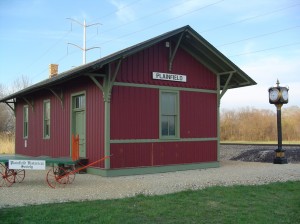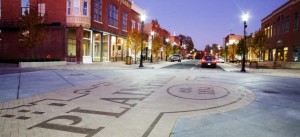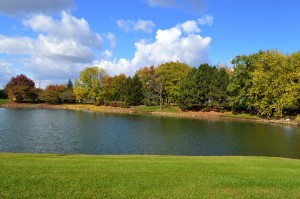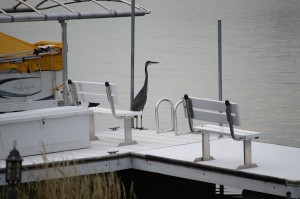 Events in the early 1800s laid the foundation for Plainfield to be established as Will County’s oldest community. Long before the arrival of the earliest white settlers, a large community of Potawatomie Indians had settled in the dense woods and vast prairie along the banks of the DuPage River. The Potawatomie built a village of semi-permanent structures and farmed small plots of land.
Events in the early 1800s laid the foundation for Plainfield to be established as Will County’s oldest community. Long before the arrival of the earliest white settlers, a large community of Potawatomie Indians had settled in the dense woods and vast prairie along the banks of the DuPage River. The Potawatomie built a village of semi-permanent structures and farmed small plots of land.
The earliest white men in the area were French fur traders such as Vetel Vermette and George Fouquier who plied their trade among the Indian communities throughout the region. Although a few of these men erected simple log cabins and may have established small claims, none actually purchased any land.
The first permanent white settler was James Walker, who was introduced to the area along the DuPage River by his father-in-law, Rev. Jesse Walker, a pioneer Methodist circuit rider. The two Walkers traveled through the area as early as 1826 on one of many trips in which Rev. Walker evangelized the Potawatomie. Two years later, in 1828, James Walker returned in the company of several men to stake claim and erect a sawmill around which the settlement of Walkers’ Grove developed. However, it was not until 1833 that the first government land sales occurred in what is today, Will County. The earliest land transactions were completed at Chicago.
 Because of the DuPage River; established routes to Ft. Dearborn (Chicago) and Ottawa; a good supply of virgin timber; and relationships established by Rev. Walker, the small community of Walkers’ Grove flourished. Lumber milled at James Walker’s mill was hauled by Reuben Flagg to Chicago in order to erect the first two frame structures in that community. Reuben Flagg and his wife Betsey, were the parents of the first white child Samantha born within the present boundaries of Will County.
Because of the DuPage River; established routes to Ft. Dearborn (Chicago) and Ottawa; a good supply of virgin timber; and relationships established by Rev. Walker, the small community of Walkers’ Grove flourished. Lumber milled at James Walker’s mill was hauled by Reuben Flagg to Chicago in order to erect the first two frame structures in that community. Reuben Flagg and his wife Betsey, were the parents of the first white child Samantha born within the present boundaries of Will County.
In 1834, the southern portion of “Planefield,” as it appears on the original plat consisting of thirteen blocks, was laid out by Chester Ingersoll and predated the creation of Will County. The new town, located Northeast of the original settlement of Walkers’ Grove was given the name Plainfield, referring . . . perhaps . . . to the flat expanse of verdant prairie stretching outward from the dense timberland along the DuPage River. In 1835, two additions were made by James Mathews and Levi Arnold. During the winter of 1835-36, Will County was separated from Cook County.
An inn and tavern was among the first businesses established on Main Street in the northern part of town; other businesses and industries located around the intersection of Joliet Road and Commercial Street in the Southern part of town. The inn, erected in 1834, was known as “Halfway House” because of its mid-point location on the Chicago-Ottawa Road, a well-traveled stage coach route. The inn also served as a residence, the first government-franchised post office in the county, the site of Cook-Will county land grants, and militia headquarters prior to the Civil War.
Meanwhile the community prospered and grew. Early industries included a cheese factory, grist mill, wagon manufacturing, a tile factory, and a foundry. Many fine, though simple, wood framed residences were erected. Several congregations were formed and built beautiful houses of worship. With the construction of the Illinois and Michigan Canal, Plainfield was bypassed by the rapid development then occurring in nearby canal towns within the county. By the late 1840s, businesses and industries began locating in the central part of the village of Lockport, Plainfield and Yorkville Plank Road, a direct route to the canal docks at Lockport. Another road in the 1851 era, the Oswego-Indiana Plank Road, also was established through the heart of Plainfield’s business district. In 1861, Plainfield College was founded, but, in 1869, was relocated to Naperville and named North Central College. On June 30, 1877, the North and South portions of the Village were incorporated under the general law of the State of Illinois.
 The EJ&E Railroad was operational in 1886 and provided freight service and grain transportation for the thriving agricultural community. In 1904, the Aurora, Plainfield & Joliet Railway established a streetcar line with a popular, twenty-acre camping resort at Plainfield. Known as Electric Park, the attraction included camping cabins, a large auditorium, a dancehall, restaurant, bowling alley, swimming and boating along the East and West banks of the DuPage River. The park closed in 1923 when the streetcars were replaced by buses.
The EJ&E Railroad was operational in 1886 and provided freight service and grain transportation for the thriving agricultural community. In 1904, the Aurora, Plainfield & Joliet Railway established a streetcar line with a popular, twenty-acre camping resort at Plainfield. Known as Electric Park, the attraction included camping cabins, a large auditorium, a dancehall, restaurant, bowling alley, swimming and boating along the East and West banks of the DuPage River. The park closed in 1923 when the streetcars were replaced by buses.
Prior to his famous solo transcontinental flight, Charles Lindbergh supervised the establishment of beacon guiding lights and emergency landing fields in the Plainfield area. Another early aviator, Eddie Gardner, was born in Plainfield and involved in the establishment of the first air mail routes.
Plainfield’s main thoroughfare Lockport Street, was chosen as the route of the Lincoln Highway, which was begun in 1913. The road was the first paved, transcontinental highway and stretched from New York to San Francisco. Later, when the U.S. Route 66 crossed the Lincoln Highway in the heart of the village, Plainfield was at the intersection of the two longest highways in the world.
By 1960, the town of Plainfield had grown attracting many new residents, businesses and industries. Although it maintained its small town image, it was slowly transforming from a small, rural community to a modern suburb in the Chicago metropolitan area. In 1976, a new village hall and police station were constructed along with other improvements throughout the village. On August 28, 1990, a devastating tornado struck the community resulting in the loss of life and property. Despite the destruction, the community mustered its pride and strength, rebuilding better what it had lost. The community continues to build towards the future while honoring its past. Today, three buildings are listed on the National Register of Historic Places, while new businesses and residences are being interwoven into the existing fabric of the community. In 1992, a new library facility was dedicated and a wildlife sanctuary was established.
 Faced with challenges of growth and with forethought for the future community, the Village of Plainfield continually builds upon its rich and proud history.
Faced with challenges of growth and with forethought for the future community, the Village of Plainfield continually builds upon its rich and proud history.


